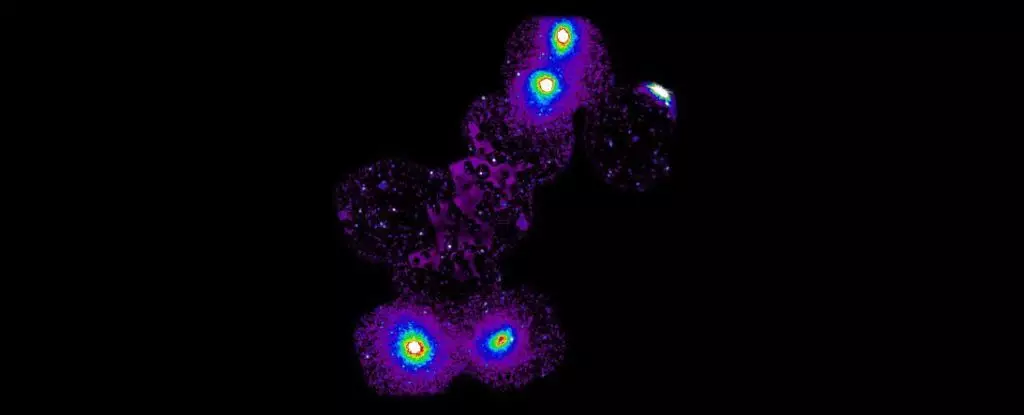In a remarkable twist of cosmic exploration, researchers have unveiled a significant find regarding the elusive ‘missing matter’ of the Universe. Utilizing advanced X-ray observations, a colossal filament of hot gas—stretching over 23 million light-years—has been identified within the Shapley Supercluster, a vast collection housing around 8,000 galaxies. Astrophysicist Konstantinos Migkas from Leiden Observatory articulated the excitement surrounding this discovery, noting, “For the first time, our results closely match what we see in our leading model of the cosmos—something that’s not happened before.” This statement encapsulates both the thrill of discovery and the ongoing complexities of cosmic understanding.
While the scientific community has long grappled with the enigma of the Universe’s matter composition, it is crucial to contextualize the significance of this finding. Only about 15 percent of the Universe’s total matter is made up of the ‘normal’ constituents we can perceive, such as protons, neutrons, and electrons. The remainder, composed of enigmatic ‘dark matter,’ eludes direct detection. This discrepancy highlights a persistent gap in our comprehension of cosmic ingredients—where has all the matter gone since the Universe’s infancy post-Big Bang?
Charting the Cosmic Web: A Tapestry of Hidden Matter
The prevailing hypothesis posits that the majority of the missing matter resides in intergalactic spaces—an extremely tenuous but abundant reservoir lying across vast stretches that remain largely unobservable. As astronomical methods and technologies have improved, fragments of evidence hinting at this hidden matter have steadily surfaced. This filament discovery is a crucial addition to a growing body of observations suggesting the cosmic web is more intricate than once imagined.
The cosmic web serves as an expansive lattice of filaments connecting galaxies through the strands of dark matter. These structures orchestrate the gravitational dance between cosmic bodies and serve as conduits for the movement of galaxies and matter. The challenge has been identifying these faint filaments, which can easily slip from sight amidst the universe’s brilliance. Battling visibility limits, Migkas and his research team creatively utilized data from two X-ray telescopes—the retired Suzaku and the operational XMM-Newton—to create a clearer picture of this cosmic structure.
Technological Collaboration: A Leap Forward in Astronomical Research
The collaboration of differing technologies underscores a significant advancement in observational astronomy. The Suzaku telescope, adept at capturing faint X-ray emissions across larger areas, paired with the precision of XMM-Newton, which excels at pinpointing bright X-ray sources, allowed researchers to revoke the specter of contamination from more vibrant sources, such as black holes. The result—the visualization of a hot gas filament—stands as a tangible testament to what’s hidden within the universe, demonstrating a successful melding of observational techniques.
According to Norbert Schartel, project scientist for XMM-Newton at the European Space Agency, this research establishes a new methodological benchmark for detecting the light emanating from faint cosmic filaments. The amalgamation of technological prowess and astrophysical insight spells a bright horizon for cosmology and reinforces the idea that hidden matter is still very much an integral part of our Universe.
The Implications of Discovery: Challenging Cosmic Understandings
While the unveiling of this hot gas filament provides the clearest evidence yet of the cosmic web’s fabric, it also poses thought-provoking questions. Does this discovery reshape our broader understanding of dark matter and fate of the cosmos? Is this a harbinger of more groundbreaking revelations waiting to be uncovered? It invites an exploration into the relationship between visible matter and dark matter, necessitating a reevaluation of existing models of cosmic evolution.
In the grand tapestry of astrophysics, each discovery is an intricate stitch, contributing to a comprehensive understanding of the Universe. That our predictions align more closely with observational evidence, as indicated by Migkas, fills researchers with both optimism and urgency in their quest to decipher the cosmos. Researchers stand on the precipice of a new age of explorations into uncharted aspects of our Universe, wherein every new filament, galaxy cluster, or piece of evidence further enriches the majestic narrative of cosmic evolution.

